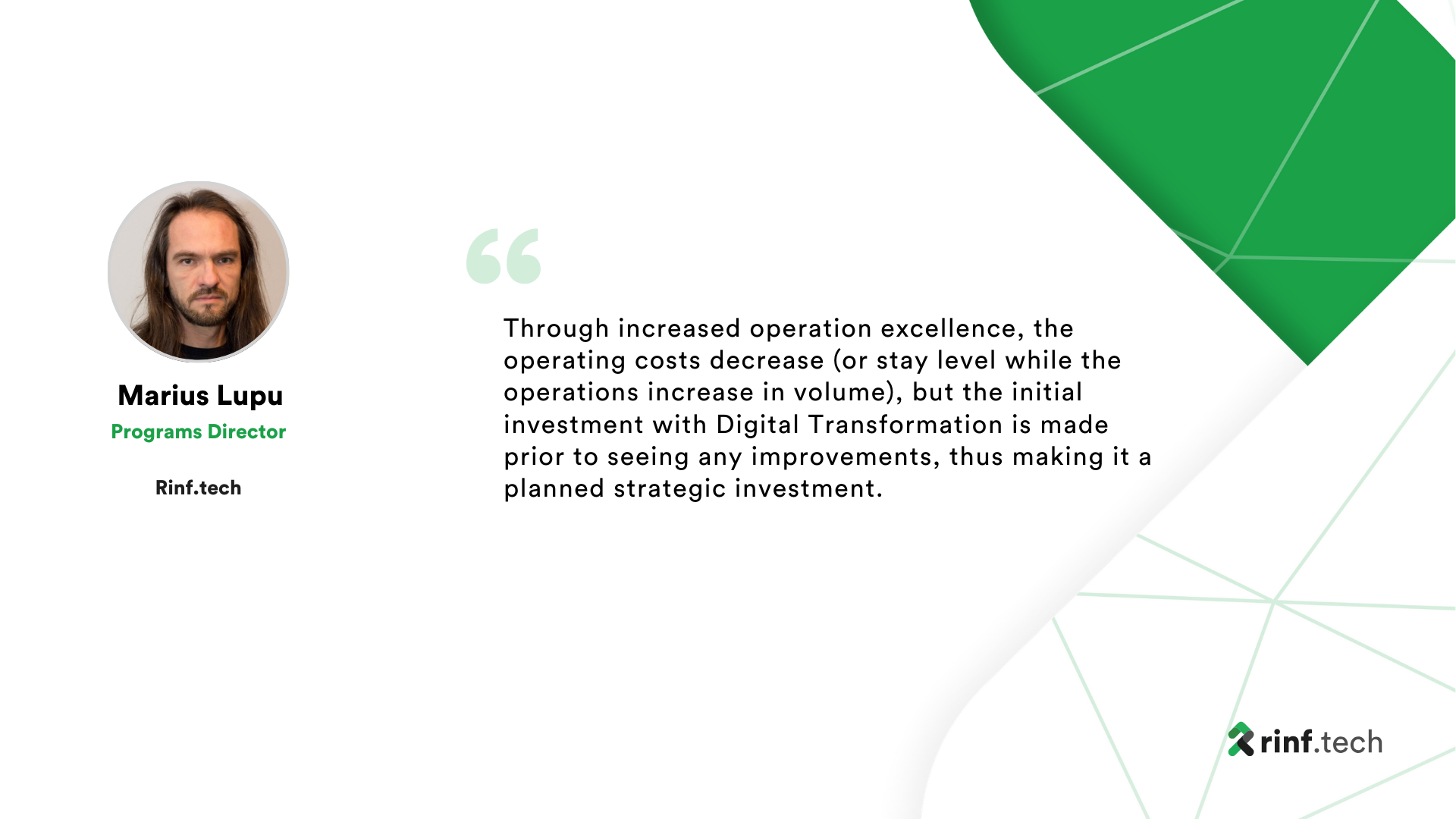
How to Roll Out an Innovation Project Within Your Company: Tips and Best Practices
This article will share three strategies to help R&D teams effectively and successfully implement new technologies.
Our Technology Team recently released the first module of their Digital Transformation (DT) initiative to automate rinf.tech‘s recruitment and internal mobility flows—a custom-built application on a RAD platform that replicates in detail the operating processes of the Talent Acquisition (TA) Team.
As the development of our internal AI-driven solution continues, our content team sat down with Marius Lupu, Programs Director at rinf.tech, to discuss the ins and outs of Digital Transformation. In this interview, Marius shares his experience and insights on a typical DT project’s what, why, and how.
In particular, Marius delves into what should drive corporate decisions to adopt DT, its business benefits, key success factors, technology selection, and more.
Enjoy the reading.
Marius Lupu: Digital Transformation (DT) is the process of introducing or upgrading the Digital Platform which supports the execution of business processes in a company. This Digital Platform refers to the set of software applications, infrastructure and tools used in daily activities by the staff of all business functions.
In its simplest form, the evidence of assets and their states is kept using spreadsheets, while the processes used to manipulate the data are described in documents, which are adopted and implemented by all staff. This approach has the advantage of being quick to deploy and easy to maintain (technology wise), but it shows its limitations when scaling, the biggest issue being data consistency (or the exponential effort to counter that). At the other end of the spectrum are the enterprise applications that cover full and bespoke implementations of all the existing processes, operating similarly to a production facility. While that may be ideal for many reasons, it is only accessible to large corporations due to its significant deployment and maintenance costs.
Each company shall find the right balance between rigidity of the implemented process and the ease of integrating exceptions – and that is one key element of Digital Transformation.
Aside from deciding where to draw the line, the other aspect included in Digital Transformation is the critical analysis of the existing processes. The way a company operates is shaped by its environment, and new processes emerge from the way staff are coping with those environmental changes and challenges. In some cases, industry practices are imported and deployed; in some others, activities that have proven to be successful are upgraded to guidelines and later to processes. Either way, a set of routines is put in place. Being done instinctively rather than programmatically, these processes are imperfect, infused with personal preferences, flawed by inertia and biases. They must be reengineered before implemented in software, using tools such as BPM (Business Process Modelling) and DDD (Domain Driven Design).
The last dimension of Digital Transformation is the proper adoption of the new tools, along with the tailored/optimized processes. Although the new processes are built on the foundation of the existing ones, slight changes in the approach may require big shifts in mindset. For example, the introduction of roles, which pushes everyone to realize that they always wear several hats; or the separation between dashboards, for processing the data in the app, and reports, which are moving data out of the app.
Once the idea that a software application moves data and aggregates it across several business areas takes shape in people’s minds, the requests to add new features to the app will keep pouring in and the old spreadsheet reports will be soon forgotten.
Each company shall find the right balance between rigidity of the implemented process and the ease of integrating exceptions – and that is one key element of Digital Transformation.
Marius: If done right, the main benefit of DT is an increase in operational excellence. In other words, with the current resources and staff, the company will be able to increase its throughput, thus allowing it to accelerate the scaling–up. On one hand, the use of software tools simplifies data processing, limits the number of mistakes and accelerates the execution by automating many steps of the processes. On the other, with all data living in the system, statistical analysis and qualitative performance observations can be performed with a much higher level of detail; for a data-oriented CEO, this is invaluable input for business development and general decision-making.
Marius: Like any other business transformation, DT is easier to explain than to do; despite clear guidelines and principles, there are many variables that can screw up the entire outcome. There are however a few ingredients that strengthen the success of such initiative:
Through increased operation excellence, the operating costs decrease (or stay level while the operations increase in volume), but the initial investment with DT is made prior to seeing any improvements, thus making it a planned strategic investment.
Marius: In Digital Transformation, software plays a crucial role. No matter the preferred solution (make or buy), a certain degree of customization is involved, and new software is developed. The best methodology to be applied in this case is Agile; the endeavor is exploratory, either we are speaking about qualified vendors that have the domain expertise and lack the understanding of the specifics of the company (‘buy’), or we are considering internal development where the two premises reverse (‘make’). Either way, the discovery phase heavily shapes the outcome.
Going Agile is hence the preferred approach, not only for the development of the software, but for the whole transformation project. It works best to start with a mission to show the direction, phrased in the theme of operational excellence, to define a BHAG (Big Hairy Audacious Goal), to know when you get there, and a handful of principles to keep your from wandering astray. Then draw a high-level map of the existing processes, pick a core one, which is critical for the value production path and get going. Needs and logic will drive you forward. On this long journey, don’t be afraid to admit failures as early as possible (sunken cost fallacy does not belong in an Agile world) and revert decisions. Of course, scouting ahead and looking past the horizon is not forbidden in Agile; on the contrary, this is how it helps you avoid the perils ahead; just avoid planning and making long term commitments – Agile is all about living in the present.
The ‘make or buy’ paradigm is not binary; there are countless flavors in between. A particular one is appealing for Agile development and for transformational projects, because it allows very short times between idea and materialization: RAD (Rapid Application Development) platforms. While they don’t have any business logic built in, as opposed to a white-label enterprise application platform, they allow for a quick and rough implementation of a concept, which can be immediately validated with the stakeholders, the Process Owners for each area in this case. Chosen carefully, a RAD framework that supports BPMN can make all the difference between a sluggish adoption by bored stakeholders and the eagerness of very engaged ones. When complemented with acquired specialized modules, such as the ERP, and with integrations with existing modules and data sources, it quickly becomes a powerful solution that supports continuous extension.

Marius: There are quite a few synthetic metrices that can be used to assess the success of a DT, such as usage rate, user satisfaction, or volume of processed data, but the ultimate indicator for success is the positive impact of increased operational excellence in the operational costs. One may look first at the indirect costs, which benefit firsthand from such initiative; support functions should be nimbler, response time shorter, productivity higher (thanks to digital tools and automation) and overall, less effort to accomplish the same tasks as before.
Time-to-market would also decrease because of increased agility and responsiveness. Depending on the business models, direct costs may also be positively influenced; this heavily depends on how the value production is distributed along the value flow: for services companies it has a lower influence than for product companies.
Marius: If there is one single recommendation to be made for companies embarking on the journey of Digital Transformation, that is: get a fresh pair of eyes. No matter how much competence a company has in the realm of change management, process assessment and modelling, holistic business views and maturity in operation, attempting a transformation requires a shift in perspective, and that is borderline impossible even for long tenure executives, despite their experience and abilities.
Turning to an external consultant is similar to turning to a therapist: it helps one overcome their biases, question alleged axioms and observe the world from a new perspective. There may be cases where companies falsely claim the need for DT when they have other issues, such as a declining business case – external support may help everyone develop a fresh view and acknowledge the real problem.

This article will share three strategies to help R&D teams effectively and successfully implement new technologies.

This article explores interesting machine learning projects that companies in various sectors can launch to gain a significant competitive advantage in a highly saturated business landscape.

This article explores top use cases of integrating ChatGPT into business strategies and operations across multiple industries and domains.